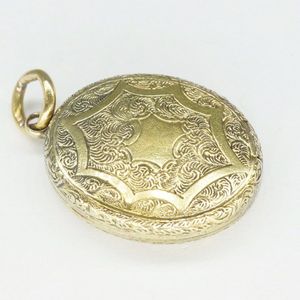Thomas Earnshaw Gold and Enamel Verge Watch
You must be a subscriber, and be logged in to view price and dealer details.
Subscribe Now to view actual auction price for this item
When you subscribe, you have the option of setting the currency in which to display prices to $Au, $US, $NZ or Stg.
- Verge Escapement - A verge escapement is an early mechanical escapement used in clocks and other timekeeping devices. It is an early form of the escapement mechanism, which is used to regulate the movement of the hands of a clock or watch. The verge escapement consists of a vertical shaft called the verge, which is mounted on the clock's main plate. Attached to the verge are two pallets, which engage with the teeth of the escape wheel. As the escape wheel turns, the pallets alternately lock and release it, allowing the movement of the clock to be regulated. The verge escapement was widely used in early mechanical clocks, but it was eventually replaced by the more accurate and reliable anchor escapement.
- Bezel - On a clock or watch, the bezel is the metal frame into which the watch or clock glass is fitted. In clocks, the bezel may include a hinge and a flange, in effect a door to the face of the clock. In jewellery the bezel is a band of metal with a projecting lip that holds the gemstone in its setting.
- Fusee - The fusee movement was used in clocks and pocket watches from the mid 17th century. The fusee is a cone shaped drum within the works that is linked to the barrel of the spring, usually by a length of chain.
As the mainspring loses its tension over time, the cone shaped barrel compensates for this by increasing the tension, by pulling the mainspring tighter, thus ensuring the time remains constant.
Use of the fusee in clocks was superseded by the "going barrel" in the mid 19th century and for pocket watches at the beginning of the 19th century.
The fusee continued to be used in marine chronometers until the 1970s. - Polychrome - Made or finished in many colours. For furniture, it is used to indicated a painted finish.
- Movement - The technical name for the workings of a clock or watch, and does not include the dial or case.
This item has been included into following indexes:
- chronometers - pocket 47
- Earnshaw, Thomas (Britain) - clocks, maker or retailer 4
-
pocket watches, case type
- enamelled decoration 161
- open face, gold / gold-plated case 1,381
- pair cased 165
- pocket watches, period - Georgian 289
Visually similar items

A 19th century yellow gold, enamel, diamond and garnet puff heart ring, possibly constructed from a locket clasp, the raised floral design on the decorative enamel puff heart form, plain band.

15ct yellow gold engraved locket with painted portrait inside, in original condition, length 26 mm by 22.5 mm, 6.4g (overall)

Good enamel scenic brooch, with gold plate surround

Vintage Maling iridescent bowl, with floral pattern, 21 cm diameter approx.
